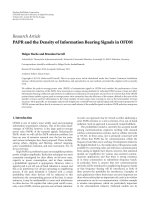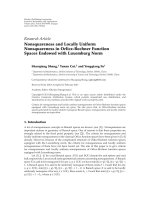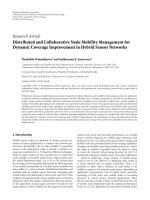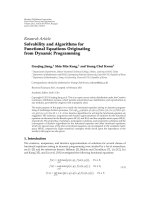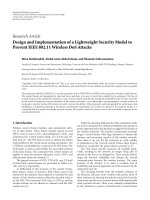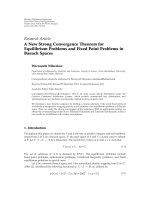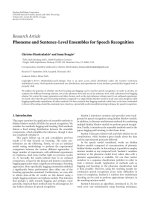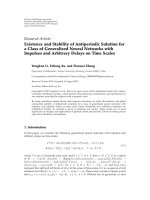Báo cáo hóa học: " Research Article Weak and Strong Convergence of an Implicit Iteration Process for an Asymptotically Quasi-I-Nonexpansive Mapping in Banach Space" doc
Bạn đang xem bản rút gọn của tài liệu. Xem và tải ngay bản đầy đủ của tài liệu tại đây (505.13 KB, 13 trang )
Hindawi Publishing Corporation
Fixed Point Theory and Applications
Volume 2010, Article ID 719631, 13 pages
doi:10.1155/2010/719631
Research Article
Weak and Strong Convergence of an Implicit
Iteration Process for an Asymptotically
Quasi-I-Nonexpansive Mapping in Banach Space
Farrukh Mukhamedov and Mansoor Saburov
Department of Computational & Theoretical Sciences, Faculty of Science, International Islamic University
Malaysia, P.O. Box 141, 25710 Kuantan, Malaysia
Correspondence should be addressed to Farrukh Mukhamedov,
Received 31 August 2009; Accepted 6 December 2009
Academic Editor: Mohamed A. Khamsi
Copyright q 2010 F. Mukhamedov and M. Saburov. This is an open access article distributed
under the Creative Commons Attribution License, which permits unrestricted use, distribution,
and reproduction in any medium, provided the original w ork is properly cited.
We prove the weak and strong convergence of the implicit iterative process to a common
fixed point of an asymptotically quasi-I-nonexpansive mapping T and an asymptotically quasi-
nonexpansive mapping I, defined on a nonempty closed convex subset of a Banach space.
1. Introduction
Let K be a nonempty subset of a real normed linear space X and let T : K → K be a mapping.
Denote by FT the set of fixed points of T,thatis,FT{x ∈ K : Tx x}. Throughout this
paper, we always assume that FT
/
∅. Now let us recall some known definitions.
Definition 1.1. A mapping T : K → K is said to be
i nonexpansive, if Tx − Ty≤x − y for all x, y ∈ K;
ii asymptotically nonexpansive, if there exists a sequence {λ
n
}⊂1, ∞ with
lim
n →∞
λ
n
1 such that T
n
x − T
n
y≤λ
n
x − y for all x, y ∈ K and n ∈ N;
iii quasi-nonexpansive, if Tx − p≤x − p for all x ∈ K, p ∈ FT;
iv asymptotically quasi-nonexpansive, if there exists a sequence {μ
n
}⊂1, ∞ with
lim
n →∞
μ
n
1 such that T
n
x − p≤μ
n
x − p for all x ∈ K, p ∈ FT and n ∈ N.
2 Fixed Point Theory and Applications
Note that from the above definitions, it follows that a nonexpansive mapping must
be asymptotically nonexpansive, and an asymptotically nonexpansive mapping must be
asymptotically quasi-nonexpansive, but the converse does not hold see 1.
If K is a closed nonempty subset of a Banach space and T : K → K is nonexpansive,
then it is known that T may not have a fixed point unlike the case if T is a strict contraction,
and even when it has, the sequence {x
n
} defined by x
n1
Tx
n
the so-called Picard sequence
may fail to converge to such a fixed point.
In 2, 3 Browder studied the iterative construction for fixed points of nonexpansive
mappings on closed and convex subsets of a Hilbert space. Note that for the past 30 years or
so, the studies of the iterative processes for the approximation of fixed points of nonexpansive
mappings and fixed points of some of their generalizations have been flourishing areas of
research for many mathematicians see for more details 1, 4.
In 5 Diaz and Metcalf studied quasi-nonexpansive mappings in Banach spaces.
Ghosh and Debnath 6 established a necessary and sufficient condition for convergence of
the Ishikawa iterates of a quasi-nonexpansive mapping on a closed convex subset of a Banach
space. The iterative approximation problems for nonexpansive mapping, asymptotically
nonexpansive mapping and asymptotically quasi-nonexpansive mapping were studied
extensively by Goebel and Kirk 7,Liu8, Wittmann 9,Reich10, Gornicki 11,Schu
12 Shioji and Takahashi 13, and Tan and Xu 14 in the settings of Hilbert spaces and
uniformly convex Banach spaces.
There are many methods for approximating fixed points of a nonexpansive mapping.
Xu and Ori 15 introduced implicit iteration process to approximate a common fixed point of
a finite family of nonexpansive mappings in a Hilbert space. Recently, Sun 16 has extended
an implicit iteration process for a finite family of nonexpansive mappings, due to Xu and Ori,
to the case of asymptotically quasi-nonexpansive mappings in a setting of Banach spaces.
In 17 it has been studied the weak and strong convergence of implicit iteration process
with errors to a common fixed point for a finite family of nonexpansive mappings in Banach
spaces, which extends and improves the mentioned papers see also 18, 19 for applications
and other methods of implicit iteration processes.
There are many concepts which generalize a notion of nonexpansive mapping. One of
such concepts is I-nonexpansivity of a mapping T 20. Let us recall some notions.
Definition 1.2. Let T : K → K, I : K → K be two mappings of a nonempty subset K of a real
normed linear space X. Then T is said to be
i I-nonexpansive, if Tx − Ty≤Ix − Iy for all x, y ∈ K;
ii asymptotically I-nonexpansive, if there exists a sequence {λ
n
}⊂1, ∞ with
lim
n →∞
λ
n
1 such that T
n
x − T
n
y≤λ
n
I
n
x − I
n
y for all x, y ∈ K and n ≥ 1;
iii asymptotically quasi I-nonexpansive mapping, if there exists a sequence {μ
n
}⊂
1, ∞ with lim
n →∞
μ
n
1 such that T
n
x − p≤μ
n
I
n
x − p for all x ∈ K, p ∈
FT ∩ FI and n ≥ 1.
Remark 1.3. If FT ∩ FI
/
∅ then an asymptotically I-nonexpansive mapping is asymptot-
ically quasi-I-nonexpansive. But, there exists a nonlinear continuous asymptotically quasi
I-nonexpansive mappings which is asymptotically I-nonexpansive.
In 21 a weakly convergence theorem for I-asymptotically quasi-nonexpansive
mapping defined in Hilbert space was proved. In 22 strong convergence of Mann
iterations of I-nonexpansive mapping has been proved. Best approximation properties of
Fixed Point Theory and Applications 3
I-nonexpansive mappings were investigated in 20.In23 the weak convergence of three-
step Noor iterative scheme for an I-nonexpansive mapping in a Banach space has been
established. Recently, in 24 the weak and strong convergence of implicit iteration process
to a common fixed point of a finite family of I-asymptotically nonexpansive mappings were
studied. Assume that the family consists of one I-asymptotically nonexpansive mapping T.
Now let us consider an iteration method used in 24,forT, which is defined by
x
1
∈ K,
x
n1
1 − α
n
x
n
α
n
I
n
y
n
,
y
n
1 − β
n
x
n
β
n
T
n
x
n
.
n ≥ 1, 1.1
where {α
n
} and {β
n
} are two sequences in 0, 1. From this formula one can easily see that the
employed method, indeed, is not implicit iterative processes. The used process is some kind
of modified Ishikawa iteration.
Therefore, in this paper we will extend of the implicit iterative process, defined in 16,
to I-asymptotically quasi-nonexpansive mapping defined on a uniformly convex Banach
space. Namely, let K be a nonempty convex subset of a real Banach space X and T : K → K
be an asymptotically quasi I-nonexpansive mapping, and let I : K → K be an asymptotically
quasi-nonexpansive mapping. Then for given two sequences {α
n
} and {β
n
} in 0, 1 we will
consider the following iteration scheme:
x
0
∈ K,
x
n
1 − α
n
x
n−1
α
n
T
n
y
n
,
y
n
1 − β
n
x
n
β
n
I
n
x
n
.
n ≥ 1, 1.2
In this paper we will prove the weak and strong convergences of the implicit iterative
process 1.2 to a common fixed point of T and I. All results presented here generalize and
extend the corresponding main results of 15–17 in a case of one mapping.
2. Preliminaries
Throughout this paper, we always assume that X is a real Banach space. We denote by FT
and DT the set of fixed points and the domain of a mapping T, respectively. Recall that
a Banach space X is said to satisfy Opial condition 25, if for each sequence {x
n
} in X, x
n
converging weakly to x implies that
lim inf
n →∞
x
n
− x
< lim inf
n →∞
x
n
− y
.
2.1
for all y ∈ X with y
/
x. It is well known that see 26 inequality 2.1 is equivalent to
lim sup
n →∞
x
n
− x
< lim sup
n →∞
x
n
− y
.
2.2
4 Fixed Point Theory and Applications
Definition 2.1. Let K be a closed subset of a real Banach space X and let T : K → K be a
mapping.
i A mapping T is said to be semiclosed demiclosed at zero, if for each bounded
sequence {x
n
} in K, the conditions x
n
converges weakly to x ∈ K and Tx
n
converges strongly to 0 imply Tx 0.
ii A mapping T is said to be semicompact, if for any bounded sequence {x
n
} in K
such that x
n
− Tx
n
→0,n→∞, then there exists a subsequence {x
n
k
}⊂{x
n
}
such that x
n
k
→ x
∗
∈ K strongly.
iii T is called a uniformly L-Lipschitzian mapping, if there exists a constant L>0 such
that T
n
x − T
n
y≤Lx − y for all x, y ∈ K and n ≥ 1.
The following lemmas play an important role in proving our main results.
Lemma 2.2 see 12. Let X be a uniformly convex Banach space and let b, c be two constants with
0 <b<c<1. Suppose that {t
n
} is a sequence in b, c and {x
n
} and {y
n
} are two sequences in X
such that
lim
n →∞
t
n
x
n
1 − t
n
y
n
d, lim sup
n →∞
x
n
≤ d, lim sup
n →∞
y
n
≤ d,
2.3
holds some d ≤ 0. Then lim
n →∞
x
n
− y
n
0.
Lemma 2.3 see 14. Let {a
n
} and {b
n
} be two sequences of nonnegative real numbers with
∞
n1
b
n
< ∞. If one of the following conditions is satisfied:
i a
n1
≤ a
n
b
n
,n≥ 1,
ii a
n1
≤ 1 b
n
a
n
,n≥ 1,
then the limit lim
n →∞
a
n
exists.
3. Main Results
In this section we will prove our main results. To formulate one, we need some auxiliary
results.
Lemma 3.1. Let X be a real Banach space and let K be a nonempty closed convex subset of X. Let
T : K → K be an asymptotically quasi I-nonexpansive mapping with a sequence {λ
n
}⊂1, ∞ and
I : K → K be an asymptotically quasi-nonexpansive mapping with a sequence {μ
n
}⊂1, ∞ such
that F FT ∩ FI
/
∅. Suppose A
∗
sup
n
α
n
, Λsup
n
λ
n
≥ 1,M sup
n
μ
n
≥ 1 and {α
n
} and
{β
n
} are two sequences in 0, 1 which satisfy the following conditions:
i
∞
n1
λ
n
μ
n
− 1α
n
< ∞,
ii A
∗
< 1/Λ
2
M
2
.
If {x
n
} is the implicit iterative sequence defined by 1.2, then for each p ∈ F FT ∩ FI the limit
lim
n →∞
x
n
− p exists.
Fixed Point Theory and Applications 5
Proof. Since F FT ∩ FI
/
∅, for any given p ∈ F, it follows from 1.2 that
x
n
− p
1 − α
n
x
n−1
− p
α
n
T
n
y
n
− p
≤
1 − α
n
x
n−1
− p
α
n
T
n
y
n
− p
≤
1 − α
n
x
n−1
− p
α
n
λ
n
I
n
y
n
− p
≤
1 − α
n
x
n−1
− p
α
n
λ
n
μ
n
y
n
− p
.
3.1
Again from 1.2 we derive that
y
n
− p
1 − β
n
x
n
− p
β
n
I
n
x
n
− p
≤
1 − β
n
x
n
− p
β
n
μ
n
x
n
− p
≤
1 − β
n
μ
n
x
n
− p
β
n
μ
n
I
n
x
n
− p
≤ μ
n
x
n
− p
,
3.2
which means
y
n
− p
≤ μ
n
x
n
− p
≤ λ
n
μ
n
x
n
− p
. 3.3
Then from 3.3 one finds
x
n
− p
≤
1 − α
n
x
n−1
− p
α
n
λ
2
n
μ
2
n
x
n
− p
,
3.4
and so
1 − α
n
λ
2
n
μ
2
n
x
n
− p
≤
1 − α
n
x
n−1
− p
. 3.5
By condition ii we have α
n
λ
2
n
μ
2
n
≤ A
∗
Λ
2
M
2
< 1, and therefore
1 − α
n
λ
2
n
μ
2
n
≥ 1 − A
∗
Λ
2
M
2
> 0.
3.6
Hence from 3.5 we obtain
x
n
− p
≤
1 − α
n
1 − α
n
λ
2
n
μ
2
n
x
n−1
− p
1
λ
2
n
μ
2
n
− 1
α
n
1 − α
n
λ
2
n
μ
2
n
x
n−1
− p
≤
1
λ
2
n
μ
2
n
− 1
α
n
1 − A
∗
Λ
2
M
2
x
n−1
− p
.
3.7
6 Fixed Point Theory and Applications
By putting b
n
λ
2
n
μ
2
n
− 1α
n
/1 − A
∗
Λ
2
M
2
the last inequality can be rewritten as f ollows:
x
n
− p
≤
1 b
n
x
n−1
− p
. 3.8
From condition i we find
∞
n1
b
n
1
1 − A
∗
Λ
2
M
2
∞
n1
λ
2
n
μ
2
n
− 1
α
n
1
1 − A
∗
Λ
2
M
2
∞
n1
λ
n
μ
n
− 1
λ
n
μ
n
1
α
n
≤
ΛM 1
1 − A
∗
Λ
2
M
2
∞
n1
λ
n
μ
n
− 1
α
n
< ∞.
3.9
Denoting a
n
x
n−1
− p in 3.8 one gets
a
n1
≤
1 b
n
a
n
, 3.10
and Lemma 2.3 implies the existence of the limit lim
n →∞
a
n
. This means the limit
lim
n →∞
x
n
− p
d
3.11
exists, where d ≥ 0 is a constant. This completes the proof.
Now we prove the following result.
Theorem 3.2. Let X be a real Banach space and let K be a nonempty closed convex subset of X. Let
T : K → K be a uniformly L
1
-Lipschitzian asymptotically quasi-I-nonexpansive mapping with a
sequence {λ
n
}⊂1, ∞ and let I : K → K be a uniformly L
2
-Lipschitzian asymptotically quasi-
nonexpansive mapping with a sequence {μ
n
}⊂1, ∞ such that F FT ∩ FI
/
∅. Suppose
A
∗
sup
n
α
n
, Λsup
n
λ
n
≥ 1,M sup
n
μ
n
≥ 1, and {α
n
} and {β
n
} are two sequences in 0, 1
which satisfy the following conditions:
i
∞
n1
λ
n
μ
n
− 1α
n
< ∞,
ii A
∗
< 1/Λ
2
M
2
.
Then the implicitly iterative sequence {x
n
} defined by 1.2 converges strongly to a common fixed
point in F FT ∩ FI
/
∅ if and only if
lim inf
n →∞
d
x
n
,F
0.
3.12
Proof. The necessity of condition 3.12 is obvious. Let us proof the sufficiency part of
theorem.
Since T, I : K → K are uniformly L-Lipschitzian mappings, so T and I are continuous
mappings. Therefore the sets FT and FI are closed. Hence F FT ∩ FI is a nonempty
closed set.
Fixed Point Theory and Applications 7
For any given p ∈ F, we have see 3.8
x
n
− p
≤
1 b
n
x
n−1
− p
, 3.13
here as before b
n
λ
2
n
μ
2
n
− 1α
n
/1 − A
∗
Λ
2
M
2
with
∞
n1
b
n
< ∞. Hence, one finds
d
x
n
,F
≤
1 b
n
d
x
n−1
,F
. 3.14
From 3.14 due to Lemma 2.3 we obtain the existence of the limit lim
n →∞
dx
n
,F.By
condition 3.12,onegets
lim
n →∞
d
x
n
,F
lim inf
n →∞
d
x
n
,F
0.
3.15
Let us prove that the sequence {x
n
} converges to a common fixed point of T and I. In
fact, due to 1 t ≤ expt for all t>0, and from 3.13,weobtain
x
n
− p
≤ exp
b
n
x
n−1
− p
. 3.16
Hence, for any positive integers m, n, from 3.16 with
∞
n1
b
n
< ∞ we find
x
nm
− p
≤ exp
b
nm
x
nm−1
− p
≤ exp
b
nm
b
nm−1
x
nm−2
− p
≤···
≤ exp
nm
in1
b
i
x
n
− p
≤ exp
∞
i1
b
i
x
n
− p
,
3.17
which means t hat
x
nm
− p
≤ W
x
n
− p
3.18
for all p ∈ F, where W exp
∞
i1
b
i
< ∞.
Since lim
n →∞
dx
n
,F0, then for any given ε>0, there exists a positive integer
number n
0
such that
d
x
n
0
,F
<
ε
W
.
3.19
Therefore there exists p
1
∈ F such that
x
n
0
− p
1
<
ε
W
.
3.20
8 Fixed Point Theory and Applications
Consequently, for all n ≥ n
0
from 3.18 we derive
x
n
− p
1
≤ W
x
n
0
− p
1
<W·
ε
W
ε,
3.21
which means that the strong convergence of the sequence {x
n
} is a common fixed point p
1
of
T and I. This proves the required assertion.
We need one more auxiliary result.
Proposition 3.3. Let X be a real uniformly convex Banach space and let K be a nonempty closed
convex subset of X. Let T : K → K be a uniformly L
1
-Lipschitzian asymptotically quasi-I-
nonexpansive mapping with a sequence {λ
n
}⊂1, ∞ and let I : K → K be a uniformly L
2
-
Lipschitzian asymptotically quasi-nonexpansive mapping with a sequence {μ
n
}⊂1, ∞ such that
F FT ∩ FI
/
∅. Suppose A
∗
inf
n
α
n
,A
∗
sup
n
α
n
, Λsup
n
λ
n
≥ 1,M sup
n
μ
n
≥ 1 and
{α
n
} and {β
n
} are two sequences in 0, 1 which satisfy the following conditions:
i
∞
n1
λ
n
μ
n
− 1α
n
< ∞,
ii 0 <A
∗
≤ A
∗
< 1/Λ
2
M
2
,
iii 0 <B
∗
inf
n
β
n
≤ sup
n
β
n
B
∗
< 1.
Then the implicitly iterative sequence {x
n
} defined by 1.2 satisfies the following:
lim
n →∞
x
n
− Tx
n
0, lim
n →∞
x
n
− Ix
n
0.
3.22
Proof. First, we will prove that
lim
n →∞
x
n
− T
n
x
n
0, lim
n →∞
x
n
− I
n
x
n
0.
3.23
According to Lemma 3.1 for any p ∈ F FT ∩ FI we have lim
n →∞
x
n
− p d.It
follows from 1.2 that
x
n
− p
1 − α
n
x
n−1
− p
α
n
T
n
y
n
− p
−→ d, n −→ ∞ . 3.24
By means of asymptotically quasi-I-nonexpansivity of T and asymptotically quasi-
nonexpansivity of I from 3.3 we get
lim sup
n →∞
T
n
y
n
− p
≤ lim sup
n →∞
λ
n
μ
n
y
n
− p
≤ lim sup
n →∞
λ
2
n
μ
2
n
x
n
− p
d.
3.25
Now using
lim sup
n →∞
x
n−1
− p
d
3.26
Fixed Point Theory and Applications 9
with 3.25 and applying Lemma 2.2 to 3.24 one finds
lim
n →∞
x
n−1
− T
n
y
n
0.
3.27
Now from 1.2 and 3.27 we infer that
lim
n →∞
x
n
− x
n−1
lim
n →∞
α
n
T
n
y
n
− x
n−1
0.
3.28
On the other hand, we have
x
n−1
− p
≤
x
n−1
− T
n
y
n
T
n
y
n
− p
≤
x
n−1
− T
n
y
n
λ
n
μ
n
y
n
− p
,
3.29
which implies
x
n−1
− p
−
x
n−1
− T
n
y
n
≤ λ
n
μ
n
y
n
− p
. 3.30
The last inequality with 3.3 yields that
x
n−1
− p
−
x
n−1
− T
n
y
n
≤ λ
n
μ
n
y
n
− p
≤ λ
2
n
μ
2
x
n
− p
.
3.31
Then 3.27 and 3.24 with the Squeeze theorem imply that
lim
n →∞
y
n
− p
d.
3.32
Again from 1.2 we can see that
y
n
− p
1 − β
n
x
n
− p
β
n
I
n
x
n
− p
−→ d, n −→ ∞ . 3.33
From 3.11 one finds
lim sup
n →∞
I
n
x
n
− p
≤ lim sup
n →∞
μ
n
x
n
− p
d.
3.34
Now applying Lemma 2.2 to 3.33 we obtain
lim
n →∞
x
n
− I
n
x
n
0.
3.35
10 Fixed Point Theory and Applications
Consider
x
n
− T
n
x
n
≤
x
n
− x
n−1
x
n−1
− T
n
y
n
T
n
y
n
− T
n
x
n
≤
x
n
− x
n−1
x
n−1
− T
n
y
n
L
1
y
n
− x
n
x
n
− x
n−1
x
n−1
− T
n
y
n
L
1
β
n
I
n
x
n
− x
n
x
n
− x
n−1
x
n−1
− T
n
y
n
L
1
β
n
I
n
x
n
− x
n
.
3.36
Then from 3.27, 3.28,and3.35 we get
lim
n →∞
x
n
− T
n
x
n
0.
3.37
Finally, from
x
n
− Tx
n
≤
x
n
− T
n
x
n
T
n
x
n
− Tx
n
≤
x
n
− T
n
x
n
L
1
T
n−1
x
n
− x
n
≤
x
n
− T
n
x
n
L
1
T
n−1
x
n
− T
n−1
x
n−1
T
n−1
x
n−1
− x
n−1
x
n−1
− x
n
≤
x
n
− T
n
x
n
L
1
L
1
x
n
− x
n−1
T
n−1
x
n−1
− x
n−1
x
n−1
− x
n
≤
x
n
− T
n
x
n
L
1
L
1
1
x
n
− x
n−1
L
1
T
n−1
x
n−1
− x
n−1
3.38
with 3.28 and 3.37 we obtain
lim
n →∞
x
n
− Tx
n
0.
3.39
Analogously, one has
x
n
− Ix
n
≤
x
n
− I
n
x
n
L
2
L
2
1
x
n
− x
n−1
L
2
I
n−1
x
n−1
− x
n−1
, 3.40
which with 3.28 and 3.35 implies
lim
n →∞
x
n
− Ix
n
0.
3.41
Now we are ready to formulate one of main results concerning weak convergence of
the sequence {x
n
}.
Fixed Point Theory and Applications 11
Theorem 3.4. Let X be a real uniformly convex Banach space satisfying Opial condition and let
K be a nonempty closed convex subset of X. Let E : X → X be an identity mapping, let
T : K → K be a uniformly L
1
-Lipschitzian asymptotically quasi-I-nonexpansive mapping with a
sequence {λ
n
}⊂1, ∞, and, I : K → K be a uniformly L
2
-Lipschitzian asymptotically quasi-
nonexpansive mapping with a sequence {μ
n
}⊂1, ∞ such that F FT ∩ FI
/
∅. Suppose
A
∗
inf
n
α
n
,A
∗
sup
n
α
n
, Λsup
n
λ
n
≥ 1,M sup
n
μ
n
≥ 1, and {α
n
} and {β
n
} are two
sequences in 0, 1 satisfying the following conditions:
i
∞
n1
λ
n
μ
n
− 1α
n
< ∞,
ii 0 <A
∗
≤ A
∗
< 1/Λ
2
M
2
.
iii 0 <B
∗
inf
n
β
n
≤ sup
n
β
n
B
∗
< 1.
If the mappings E − T and E − I are semiclosed at zero, then the implicitly iterative sequence {x
n
}
defined by 1.2 converges weakly to a common fixed point of T and I.
Proof. Let p ∈ F, then according to Lemma 3.1 the sequence {x
n
− p} converges. This
provides that {x
n
} is a bounded sequence. Since X is uniformly convex, then every bounded
subset of X is weakly compact. Since {x
n
} is a bounded sequence in K, then there exists a
subsequence {x
n
k
}⊂{x
n
} such that {x
n
k
} converges weakly to q ∈ K. Hence from 3.39 and
3.41 it follows that
lim
n
k
→∞
x
n
k
− Tx
n
k
0, lim
n
k
→∞
x
n
k
− Ix
n
k
0.
3.42
Since the mappings E − T and E − I are semiclosed at zero, therefore, we find Tq q and
Iq q, which means q ∈ F FT ∩ FI.
Finally, let us prove that {x
n
} converges weakly to q. In fact, suppose the contrary, that
is, there exists some subsequence {x
n
j
}⊂{x
n
} such that {x
n
j
} converges weakly to q
1
∈ K and
q
1
/
q. Then by the same method as given above, we can also prove that q
1
∈ F FT ∩ FI.
Taking p q and p q
1
and using the same argument given in the proof of 3.11,we
can prove that the limits lim
n →∞
x
n
− q and lim
n →∞
x
n
− q
1
exist, and we have
lim
n →∞
x
n
− q
d, lim
n →∞
x
n
− q
1
d
1
,
3.43
where d and d
1
are two nonnegative numbers. By virtue of the Opial condition of X,one
finds
d lim sup
n
k
→∞
x
n
k
− q
< lim sup
n
k
→∞
x
n
k
− q
1
d
1
lim sup
n
j
→∞
x
n
j
− q
1
< lim sup
n
j
→∞
x
n
j
− q
d.
3.44
This is a contradiction. Hence q
1
q. This implies that {x
n
} converges weakly to q. This
completes the proof of Theorem 3.4.
Now we formulate next result concerning strong convergence of the sequence {x
n
}.
12 Fixed Point Theory and Applications
Theorem 3.5. Let X be a real uniformly convex Banach space and let K be a nonempty closed
convex subset of X. Let T : K → K be a uniformly L
1
-Lipschitzian asymptotically quasi-I-
nonexpansive mapping with a sequence {λ
n
}⊂1, ∞ and I : K → K be a uniformly L
2
-
Lipschitzian asymptotically quasi-nonexpansive mapping with a sequence {μ
n
}⊂1, ∞ such that
F FT ∩ FI
/
∅. Suppose A
∗
inf
n
α
n
,A
∗
sup
n
α
n
, Λsup
n
λ
n
≥ 1,M sup
n
μ
n
≥ 1 and
{α
n
} and {β
n
} are two sequences in 0, 1 satisfying the following conditions:
i
∞
n1
λ
n
μ
n
− 1α
n
< ∞,
ii 0 <A
∗
≤ A
∗
< 1/Λ
2
M
2
.
iii 0 <B
∗
inf
n
β
n
≤ sup
n
β
n
B
∗
< 1
If at least one mapping of the mappings T and I is semicompact, then the implicitly iterative sequence
{x
n
} defined by 1.2 converges strongly to a common fixed point of T and I.
Proof. Without any loss of generality, we may assume that T is semicompact. This with 3.39
means that there exists a subsequence {x
n
k
}⊂{x
n
} such that x
n
k
→ x
∗
strongly and x
∗
∈ K.
Since T, I are continuous, then from 3.39 and 3.41 we find
x
∗
− Tx
∗
lim
n
k
→∞
x
n
k
− Tx
n
k
0,
x
∗
− Ix
∗
lim
n
k
→∞
x
n
k
− Ix
n
k
0.
3.45
This shows that x
∗
∈ F FT ∩ FI. According to Lemma 3.1 the limit lim
n →∞
x
n
− x
∗
exists. Then
lim
n →∞
x
n
− x
∗
lim
n
k
→∞
x
n
k
− x
∗
0,
3.46
which means t hat {x
n
} converges to x
∗
∈ F. This completes the proof.
Note that all results presented here generalize and extend the corresponding main
results of 15–17 in a case of one mapping.
Acknowledgment
The authors acknowledge the MOSTI Grant 01-01-08-SF0079.
References
1 K. Goebel and W. A. Kirk, Topics in Metric Fixed Point Theory, vol. 28 of Cambridge Studies in Advanced
Mathematics, Cambridge University Press, Cambridge, UK, 1990.
2 F. E. Browder, “Nonexpansive nonlinear operators in a Banach space,” Proceedings of the National
Academy of Sciences of the United States of America, vol. 54, pp. 1041–1044, 1965.
3 F. E. Browder, “Convergence of approximants to fixed points of nonexpansive non-linear mappings
in Banach spaces,” Archive for Rational Mechanics and Analysis, vol. 24, pp. 82–90, 1967.
4 Ch. Chidume, Geometric Properties of Banach Spaces and Nonlinear Iterations, vol. 1965 of Lecture Notes
in Mathematics, Springer, London, UK, 2009.
5 J. B. Diaz and F. T. Metcalf, “On the structure of the set of subsequential limit points of successive
approximations,” Bulletin of the American Mathematical Society, vol. 73, pp. 516–519, 1967.
6 M. K. Ghosh and L. Debnath, “Convergence of Ishikawa iterates of quasi-nonexpansive mappings,”
Journal of Mathematical Analysis and Applications, vol. 207, no. 1, pp. 96–103, 1997.
Fixed Point Theory and Applications 13
7 K. Goebel and W. A. Kirk, “A fixed point theorem for asymptotically nonexpansive mappings,”
Proceedings of the American Mathematical Society, vol. 35, pp. 171–174, 1972.
8 Q. Liu, “Iterative sequences for asymptotically quasi-nonexpansive mappings,” Journal of Mathemati-
cal Analysis and Applications, vol. 259, no. 1, pp. 1–7, 2001.
9 R. Wittmann, “Approximation of fixed points of nonexpansive mappings,” Archiv der Mathematik, vol.
58, no. 5, pp. 486–491, 1992.
10 S. Reich, “Strong convergence theorems for resolvents of accretive operators in Banach spaces,”
Journal of Mathematical Analysis and Applications, vol. 75, no. 1, pp. 287–292, 1980.
11 J. Gornicki, “Weak convergence theorems for asymptotically nonexpansive mappings in uniformly
convex Banach spaces,” Commentationes Mathematicae Universitatis Carolinae, vol. 30, no. 2, pp. 249–
252, 1989.
12 J. Schu, “Weak and strong convergence to fixed points of asymptotically nonexpansive mappings,”
Bulletin of the Australian Mathematical Society, vol. 43, no. 1, pp. 153–159, 1991.
13 N. Shioji and W. Takahashi, “Strong convergence theorems for asymptotically nonexpansive
semigroups in Hilbert spaces,” Nonlinear Analysis: Theory, Methods & Applications, vol. 34, no. 1, pp.
87–99, 1998.
14 K K. Tan and H K. Xu, “Approximating fixed points of nonexpansive mappings b y the Ishikawa
iteration process,” Journal of Mathematical Analysis and Applications, vol. 178, no. 2, pp. 301–308, 1993.
15 H K. Xu and R. G. Ori, “An implicit iteration process for nonexpansive mappings,” Numerical
Functional Analysis and Optimization, vol. 22, no. 5-6, pp. 767–773, 2001.
16 Z H. Sun, “Strong convergence of an implicit iteration process for a finite family of asymptotically
quasi-nonexpansive mappings,” Journal of Mathematical Analysis and Applications, vol. 286, no. 1, pp.
351–358, 2003.
17 F. Gu and J. Lu, “A new composite implicit iterative process for a finite family of nonexpansive
mappings in Banach spaces,” Fixed Point Theory and Applications, vol. 2006, Article ID 82738, 11 pages,
2006.
18 H. Y. Li and H. Z. Li, “Strong convergence of an iterative method for equilibrium problems and
variational inequality problems,” Fixed Point Theory and Applications, vol. 2009, Article ID 362191, 21
pages, 2009.
19 F. Zhang and Y. Su, “Strong convergence of modified implicit iteration processes for common fixed
points of nonexpansive mappings,” Fixed Point Theory and Applications, vol. 2007, Article ID 48174, 9
pages, 2007.
20 N. Shahzad, “Generalized I-nonexpansive maps and best approximations in Banach spaces,”
Demonstratio Mathematica
, vol. 37, no. 3, pp. 597–600, 2004.
21 S. Temir and O. Gul, “Convergence theorem for I-asymptotically quasi-nonexpansive mapping in
Hilbert space,” Journal of Mathematical Analysis and Applications, vol. 329, no. 2, pp. 759–765, 2007.
22 B. H. Rhodes and S. Temir, “Convergebce thorems for I-nonexpansive mapping,” International Journal
of Mathematics and Mathematical Sciences, vol. 2006, Article ID 63435, 4 pages, 2006.
23 P. Kumam, W. Kumethong, and N. Jewwaiworn, “Weak convergence theorems of three-step Noor
iterative scheme for I-quasi-nonexpansive mappings in Banach spaces,” Applied Mathematical Sciences,
vol. 2, no. 57–60, pp. 2915–2920, 2008.
24 S. Temir, “On the convergence theorems of implicit iteration process for a finite family of I-
asymptotically nonexpansive mappings,” Journal of Computational and Applied Mathematics, vol. 225,
no. 2, pp. 398–405, 2009.
25 Z. Opial, “Weak convergence of the sequence of successive approximations for nonexpansive
mappings,” Bulletin of the American Mathematical Society, vol. 73, pp. 591–597, 1967.
26 E. Lami Dozo, “Multivalued nonexpansive mappings and Opial’s condition,” Proceedings of the
American Mathematical Society, vol. 38, pp. 286–292, 1973.
